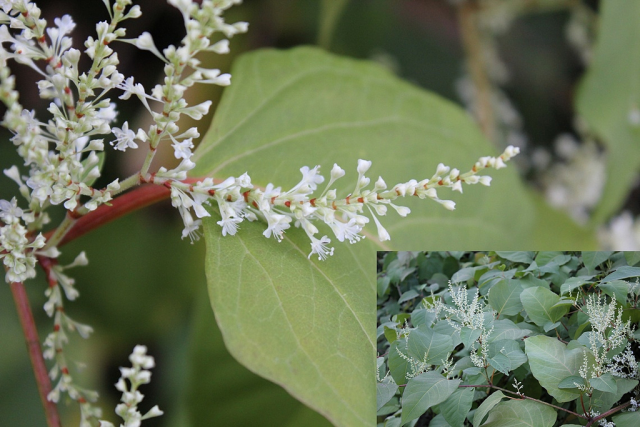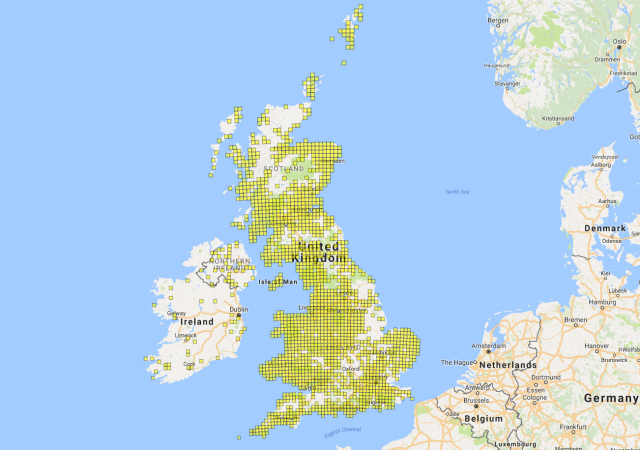Since the introduction of Japanese Knotweed as an ornamental plant in the nineteenth century, it has spread throughout watercourses, transport routes and waste ground, out-competing native plants and damaging buildings and infrastructure. This article examines some of the legislative options available for tackling it and asks whether some of the measures pursued elsewhere may be applicable in Northern Ireland.

Is the current legislative framework in Northern Ireland adequate to deal with the spreading problem of Japanese Knotweed?
The distribution of Japanese Knotweed is widespread and common across the UK, as shown by this data from the National Biological Network Database:

The Invasive Species Strategy NI describes Japanese Knotweed as an invasive plant that spreads from site to site via vegetative means. According to Invasive Species Ireland (a joint venture between the Northern Ireland Environment Agency and the National Parks and Wildlife Agency) it was introduced from Japan to the island of Ireland in the nineteenth century as an ornamental plant. Since its introduction it has spread throughout the island particularly along watercourses, transport routes and waste grounds. It out-competes native plants and can damage buildings, hard surfaces and infrastructure. Its ability to produce a new plant from tiny amounts of cut stem, crown or rhizome make its growth and spread extremely difficult to control.
Japanese Knotweed’s presence in Northern Ireland has been problematic due to its detrimental effect on the economy. According to research, invasive species cost the GB economy at least £1.7 billion per year. According to the Invasive Species Strategy NI, around £1 billion of this total cost went to the horticultural and agricultural sectors and £227 million to the construction sector.
The Strategy emphasised that Japanese Knotweed alone is estimated to cost the GB economy £179 million a year. At the NI level, research conducted for Invasive Species Ireland projected annual costs of Japanese Knotweed to be £4,730,256 to NI construction, £35,074 in house devaluation, £14,080 in costs to households and £13,577 in local authority management costs.
The current situation in Northern Ireland
As the new EU Regulation to address invasive alien species does not include Japanese Knotweed, does Northern Ireland have the legislative capacity to deal with the growing problem?
Japanese Knotweed is classed as an invasive species under Schedule 9 of the Wildlife (Northern Ireland) Order 1985 as amended by Schedule 1 of the Wildlife and Natural Environment Act (Northern Ireland) 2011. The legislation makes it an offence to plant or grow in the wild any invasive plants listed.
If excavated and removed from land, Japanese Knotweed becomes a ‘waste’. As a waste, a duty of care (under the Controlled Waste (Duty of Care) Regulations 2002) is placed on the land owner to ensure the control of the spread of Japanese Knotweed to adjacent land. According to Invasive Species Ireland, the Waste Management Regulations (NI) 2006 (as amended) require the occupier of domestic properties to ensure that any transfer of waste from their household is only to an authorised person or to a person for authorised transport purposes.
However, the problem lies with the spread of Japanese Knotweed from private land. Northern Ireland departments and local councils have no legal responsibility for the removal of Japanese Knotweed on any private land, nor can they compel a landowner to remove it from their own land – this is considered as a civil matter dealt with by common law. There is no legal requirement for a landowner to control or remove existing established areas of Japanese Knotweed from their own land.
Other jurisdictions
Similar to here, in England and Wales it is not illegal to have Japanese Knotweed on your land, and owners disposing of it illegally may be prosecuted through waste duty of care legislation. Disputes surrounding the spread of Japanese Knotweed from one property to another are considered a civil matter between landowners.
In Scotland, legislation is aimed at preventing non-native species, including Japanese Knotweed, spreading into the wild, but it does not require people to control invasive species on their land. Any dispute regarding the spread of non-native species is seen as a civil matter.
Compared to NI, legislation in the Republic of Ireland is not just as limited. The ROI extends the offence beyond growing Japanese Knotweed in the wild, to including its spread or dispersal anywhere in the ROI. However, the legislation does not explicitly state that it is an offence to allow it to spread to a neighbouring property.
For more information on legislation in other jurisdictions see RaISe Research Paper: Japanese Knotweed (NIAR 016-17).
Recent legislation introduced in England in 2014 and 2015 gives powers and mechanisms to control the spread of Japanese Knotweed from one property to another. While a change in legislation may not provide an automatic solution, the following section explores in more detail the powers introduced in England.
England
Powers have been introduced in England under Part 4 of the Infrastructure Act 2015. The powers came into effect in April 2015 and introduced two new measures to tackle Japanese Knotweed. These allow environmental authorities in England (the Secretary of State, Natural England, the Environment Agency, and the Forestry Commissioners) to enter into species control agreements (SCAs) with landowners, and if necessary, to impose species control orders (SCOs).
SCAs – these encourage environmental authorities to seek to agree a voluntary arrangement with landowners to take steps to control Japanese Knotweed present on the land.
SCOs – should the owner refuse to enter into an SCA, breach the terms of an SCA, or where immediate action is required, an environmental authority can impose an SCO on the owner.
The SCO is used to compel the owner to take particular steps to control the Knotweed, or alternatively it gives power to the environmental authority to enter onto the land and undertake the steps required. Where the environmental authority performs the works itself, the Act enables authorities to recover their reasonable costs from the owner.
In England, the Anti-Social Behaviour, Crime and Policing Act 2014 introduced Community Protection Notices which are intended to deal with unreasonable, ongoing problems or nuisances which negatively affects the quality of life of a community (Section 43).
Japanese Knotweed is not explicitly referred to in the 2014 Act. However, a Home Office information note, indicated that Community Protection Notices could possibly be used to require someone to prevent or control the growth of Japanese Knotweed or other plant that is capable of causing serious problems to communities.
Legislation in Northern Ireland under the Anti-Social Behaviour (Northern Ireland) Order 2004 gives local councils powers to intervene to address statutory nuisances or anti-social behaviour. However, to date this legislation has not been used to deal with Japanese Knotweed in Northern Ireland. This begs the question that if Japanese Knotweed could be classed as either one, could this provide a potential avenue for legal redress?
EU Regulation
Japanese Knotweed is a widespread problem across Europe. A new EU Regulation which requires Member States to produce management plans to address invasive alien species, identified in a list, entered into force in January 2015. However, the list does not include Japanese Knotweed; according to the European Commission (questions and answers), there was insufficient evidence that Japanese Knotweed meets the criteria for listing. A paper by the European Parliament Research Service refers to criticism by the European Parliament and NGOs that the list does not include some problem species, including Japanese Knotweed.
That said, the Commission states that the compilation of the list is an ongoing process and will continue to be updated. Member States may also suggest additional species to be listed which must go through an approval process. Whether the list will be updated to include Japanese Knotweed remains to be seen.
With the current exclusion of Japanese Knotweed from the list, it may be left up to the discretion of individual Member States to address the problem domestically. While England provides the only example of legislation discussed in this article that deals directly with the spread of Japanese Knotweed, given time, more countries may decide to produce their own legislation to tackle the problem. On the other hand, some countries may see the lack of an EU requirement as a reason not to take any action.

